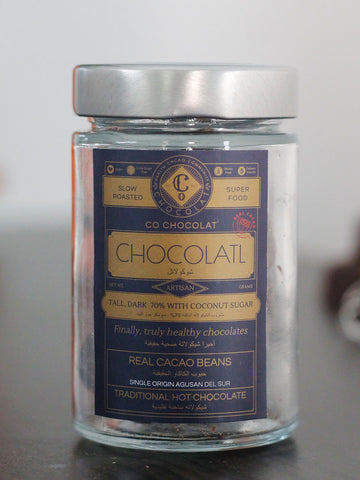Feature Article: Salmon - Health benefits, facts, and research
 8.3 min read
8.3 min read
We wanted to share with you this interesting article the we stumbled upon as we were searching for inspiration for healthy chocolatey recipes, so we are featuring this in our blog. Click here for the original article.
Last updated
Salmon is a commonly consumed fish praised for its high protein content and omega-3 fatty acids. There are several types of salmon found in the northern Atlantic and Pacific oceans and eaten in many cultures around the world. Salmon aquaculture is the fastest-growing global food production system. This MNT Knowledge Center feature is part of a collection of articles on the health benefits of popular foods. It provides a nutritional breakdown of salmon and an in-depth look at its possible health benefits, how to incorporate more salmon into your diet and any potential health risks of consuming salmon. Possible benefits of consuming salmon 
Salmon is an extremely healthful meal option. Many studies have suggested that increasing the consumption of fatty fish such as salmon decreases the risk of obesity, diabetes, and heart disease. Dietary intake of salmon also supports healthful cholesterol levels.
Salmon is a fantastic alternative to protein sources such as chicken or beef. It provides ample protein but far less saturated fat content, making salmon an ideal protein source for maintaining weight loss or a normal-range body mass index (BMI). Heart health A recent study on the connection between omega-3 fatty acids and cardiovascular disease (CVD) demonstrated that the intake of these fatty acids are linked to better cardiovascular health. The researchers advised that two servings of fatty fish per week, such as omega-3 rich salmon, is a healthful dietary pattern for the heart.
Population studies have linked baked or boiled fish intake to a reduced heart rate and a lower riskof ischemic heart disease and heart failure
Researchers also noted during separate observational studies that both Japanese and Inuit people experienced a lower risk of heart disease deaths than the risk typically seen in Western countries.
These are two cultures that eat large quantities of fatty fish, and the study maintains that the types of fatty acid content in the fish is partly responsible for these protective effects. Thyroid disease Studies have shown selenium to be necessary for healthful thyroid function.
A meta-analysis has indicated that people with thyroid disease who are selenium deficient experience pronounced benefits when increasing their selenium intake, including weight loss and a related reduction in the risk of cardiovascular disease and diabetes.
Salmon is a good source of selenium. Mental benefits Salmon can benefit the brain and cognitive processs Researchers recently found that the consumption of many of the nutrients found in fish is connected to lower risk of affective disorders, such as depression. Polyunsaturated fatty acids have also shown a relationship with a reduced risk of psychoses, cognitive deficits, dementia, and hyperkinetic disorders, such as ADHD.
According to the National Institute on Alcohol and Abuse and Alcoholism, omega-3 fatty acids have also been shown to decrease aggression, impulsivity, and depression in adults.
The associated decrease is even stronger for children with mood disorders and disorderly conduct issues aged between 4 and 12 years, such as some types of attention deficit hyperactivity disorder (ADHD).
A long-term study conducted in the UK indicated that children born to women who ate at least 12 oz of fish per week during pregnancy had higher IQs and better social, fine motor, and communication skills.
Nutritional breakdown of salmon 
Wild salmon contains more nutritional value than farmed salmon. Salmon contains a wide range of nutrients to strengthen the body. According to the USDA National Nutrient Database, 3 ounces (oz) or approximately 85 grams (g) of cooked Atlantic salmon contains:
-
175 calories
-
10.5 g of fat
-
0 g of carbohydrate
-
18.79 g of protein
The same amount of cooked Atlantic salmon also provides:
-
82 percent of the recommended daily allowance (RDA) of vitamin B12
-
46 percent of selenium
-
28 percent of niacin
-
23 percent of phosphorus
-
12 percent of thiamin
-
4 percent of vitamin A
Wild salmon is more nutrient-dense than farmed salmon. The same database advises that the same quantity of wild salmon contains:
-
118 calories
-
3.65 g of fat
-
0 g of carbohydrate
-
19.93 g of protein
It also gives a person:
-
177 percent of the recommended daily allowance (RDA) of vitamin B12
-
64 percent of vitamin D
-
59 percent of selenium
-
48 percent of niacin
-
39 percent of phosphorus
-
5 percent of thiamin
-
4.8 percent of vitamin A
Salmon also contains cholesterol. The cholesterol content of foods does not necessarily increaselevels of harmful cholesterol in the body. Saturated fat and trans fat intake is more directly related to an increase in harmful cholesterol levels, and salmon is not a significant source of either. Fish and shellfish are especially important for providing omega-3 fatty acids. These are found in few other food groups.
How to incorporate more salmon into your diet 
Salmon burgers are just one way to eat more salmon. Salmon can easily replace less healthful options in a meal as the main source of protein. Here are some quick, tasty tips on working more salmon into your diet:
-
Use salmon as a main source of protein.
-
Add salmon to pasta or rice dishes.
-
Mince salmon to top salads.
-
Make salmon patties or burgers.
-
Substitute chicken salad for salmon salad
Alternatively, try these healthful and delicious recipes developed by registered dietitians:
Potential health risks of consuming salmon
Salmon is not healthful to eat daily, as it can contain moderate levels of mercury and pollutants. These can build up in the natural environment of the salmon. As a result, oily fish should be consumed no more than four times per week.
Foods that are potentially high in mercury can be harmful to a woman if she is pregnant. During pregnancy, it is recommended that women eat no more than 2 portions of fish per week while excluding all high-mercury fish like swordfish and king mackerel.
Pollutants are found mainly in the skin and visible fat. A 1991 study advised that removing the skin can reduce the risk of exposure to contaminants. The question of the benefits of salmon skin is often raised. While they are unlikely to cause health problems, it is more healthful to remove the skin or buy pre-skinned salmon.
Atlantic salmon is often farm-raised, which is more affordable. It is, however, a less healthful choice.
Farm-raised salmon has more saturated fat and more calories, and is raised in an unnatural environment. Those wanting to avoid red dyes in fish feed, antibiotics, and less healthful farming practices should choose wild salmon, most often from the Pacific or Alaska.
Here are some important tips to minimize the risk of foodborne illnesses:
-
Buy fresh salmon properly refrigerated at 40 °F or below.
-
Pick up salmon at the end of a shopping trip to minimize exposure to warmer temperatures.
-
Discard salmon that has an overtly pungent or fishy smell.
-
Be sure to defrost frozen salmon in the refrigerator. This limits the opportunity for harmful bacteria to grow.







